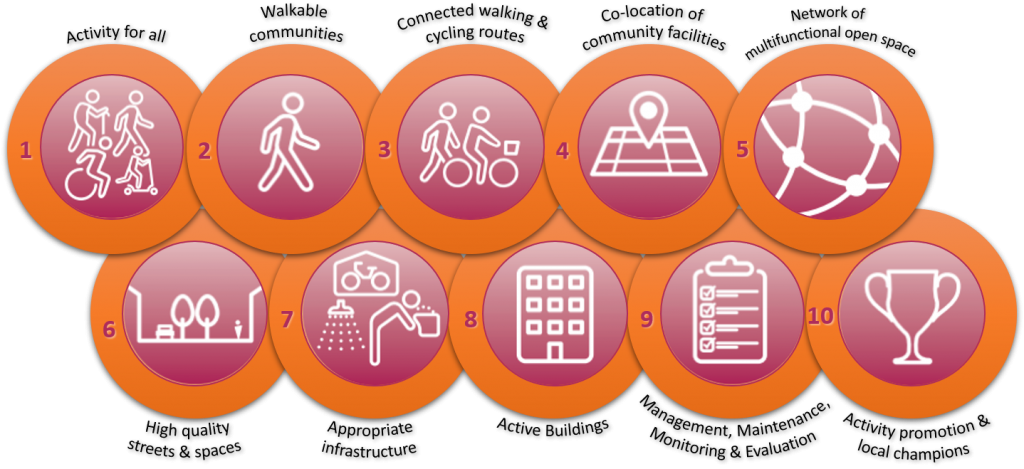Implementing Active Design Principles in Community Planning Using BREEAM
BREEAM Communities is a certification standard used to assess communitiy masterplanning and regeneration projects.
There are 5 assessment categories covering issues from: governance, wellbeing, resource efficiency and transport. If a project meets the issues highlighted below it could also meet the Active Design aspirations published by Sport England.

How can BREEAM Communities Contribute to Active Design?
Assessment Issues with a Strong Contribution
Governance 01 : Consultation Plan
Credits are awarded for considering the needs, ideas and knowledge of the community.
Aligns with all active design principles.
Governance 02 : Consultation and Engagement
Credits are awarded for recognising the quality of stakeholder engagement, throughout the design, planning and construction process.
Aligns with all active design principles.
Governance 03: Design Review
Credits are awarded when the masterplan’s design is reviewed by the community and other key stakeholders, ensuring that it supports a vibrant, healthy, functional and inclusive development.
Aligns with all active design principles.
Governance 04: Community management of facilities
Credits are awarded for community facilities which are assessed on the management and active development of their facilities.
Aligns with active design principle 9.
Social and Economic Wellbeing 02: Demographic Needs and Priorities
Credits are awarded if the development is designed for all needs and accessibility levels.
Aligns with active design principle 1.
Social and Economic Wellbeing 06: Delivery of Services, Facilities and Amenities.
Credits are given where essential facilities are provided and located within a reasonable and safe walking distance from the community centre.
Aligns with active design principles 2, 4 and 9.
Social and Economic Wellbeing 07: Public Realm
Credits are awarded for the connectivity throughout the development, promoting active travel and movement.
Aligns with active design principles 1, 2, 4, 5 and 6.
Social and Economic Wellbeing 11: Green Infrastructure
Credits are awarded for green space within walking distance of the development via safe walking and cycling routes. This promotes Active travel options.
Aligns with active design principles 1, 2, 5, 9 and 10.
Social and Economic Wellbeing 15: Inclusive Design
Credits are awarded for an inclusive design where there is infrastructure in place to increase accessibility of current and future users.
Aligns with active design principles 1 and 7.
Transport and Movement 01: Transport Assessment
Credits are awarded where transport and movement strategies reduce the impact of the development upon the existing transport infrastructure and improve environmental and social sustainability through transport.
Aligns with active design principle 2.
Transport and Movement 02: Safe and Appealing Streets
Credits are awarded where there is infrastructure in place to create safe and appealing spaces that encourage human interaction and a positive sense of place.
Aligns with active design principles 1, 2 and 6.
Transport and Movement 03: Cycling Network
Credits are given to recognise safe cycle routes where there is access to cycle paths via a safe pedestrian route.
Aligns with active design principles 2 and 3.
Assessment Issues with a Moderate Contribution
Social and Economic Wellbeing 12: Local Parking
Credits are awarded for providing parking for all the expected users.
Aligns with active design principles 1 and 2.
Transport and Movement 04: Access to Public Transport
Credits are awarded where there is availability of frequent and convenient public transport links to fixed public transport nodes (train, bus, tram or tube) and local centres.
Aligns with active design principle 2.
Transport and Movement 05: Cycling Facilities Access to Public Transport
Credits are awarded where appropriate cycling facilities for the development have been put into place which encourages active travel.
Aligns with active design principle 7.
Transport and Movement 06: Public Transport Facilities
Credits are awarded for recognising appropriate infrastructure for public transport such as bus shelters and cycle storage.
Aligns with active design principle 7.
Assessment Issues with a Minor Contribution
Land Use and Ecology 01: Ecology Strategy
Credits are awarded for improving the ecological value of the site, including provision of greenspace and habitat creation/enhancement.
Aligns with active design principle 5.
Land Use and Ecology 03: Water Pollution
Credits are awarded for measures put in place to protect the local watercourse from pollution and other environmental damage.
Aligns with active design principle 5.
Land Use and Ecology 04: Enhancement of Ecological Value
Credits are awarded for meeting Biodiversity net gain targets which are contributed by ecological enhancement and creation.
Aligns with active design principle 5.
Land use and Ecology 05: Landscape
Credits are awrded for the character of the landscape, it’s maintenance and it’s continued enhancement.
Aligns with active design principle 5.


